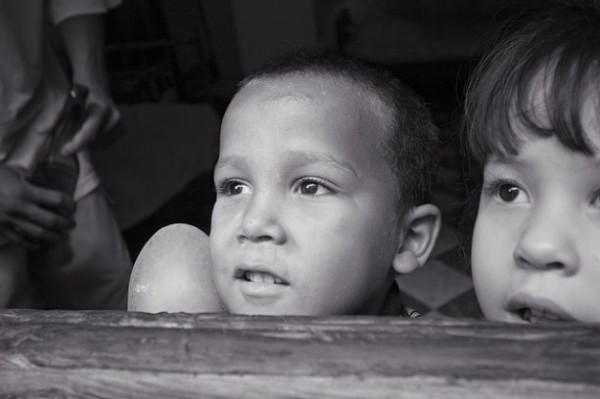
Cuba has been envisioned by Americans as many things: island paradise, communist stronghold, and Hemingway’s retreat, to name a few. Today, political reforms and a loosening of trade restrictions are giving rise to yet another Cuba. In advance of a panel about Cuba in the American imagination, we asked experts what they think the nation will look like in the next ten years.
A Consumerist Cuba
 When I first traveled to Cuba in 1995, my immediate and surprising impressions had mostly to do with the heat, the noise, and the riot of color–the crowded, lively streets, the vegetation, and the clothes people wore. Without being aware of it, I’d imagined the country as cold, silent, and gray. It had truly never occurred to me that Cuba was a tropical, Caribbean island.
When I first traveled to Cuba in 1995, my immediate and surprising impressions had mostly to do with the heat, the noise, and the riot of color–the crowded, lively streets, the vegetation, and the clothes people wore. Without being aware of it, I’d imagined the country as cold, silent, and gray. It had truly never occurred to me that Cuba was a tropical, Caribbean island.
Every semester I’m newly surprised that my students continue to hold such Cold-War-infused ideas about Cuba. “Repression,” they say confidently. “Communism doesn’t work.”
They have never thought to question whether capitalism works. Surrounded by the plethora of consumer goods of the post-industrial United States, most are blissfully unaware of the collateral damage of their standard of living: the wars, the hunger, the child labor, the nuclear waste. No need to dwell on capitalism’s underside. Instead, they can contrast their consumerist heaven with the chilled monochrome that they imagine of Cuba.
Aviva Chomsky is professor of history and coordinator of Latin American Studies at Salem State University. She has written and edited several books including The Cuba Reader: History, Culture, Politics and her newest book A History of the Cuban Revolution.
—————————————————————————————————————
… Pretty Much Like China
 As the Arab Spring of 2011 suggests, the stifling economic and political control Cuban authorities maintain over their people cannot be maintained indefinitely. Perhaps, during the height of the Cold War, Cuba’s leaders had reasonable cause to maintain absolute power (particularly in light of US efforts to overthrow the Castro government), but with the Cold War over and U.S. interests directed elsewhere, the harshness of Cuba’s control over its population no longer makes any political, economic or social sense.
As the Arab Spring of 2011 suggests, the stifling economic and political control Cuban authorities maintain over their people cannot be maintained indefinitely. Perhaps, during the height of the Cold War, Cuba’s leaders had reasonable cause to maintain absolute power (particularly in light of US efforts to overthrow the Castro government), but with the Cold War over and U.S. interests directed elsewhere, the harshness of Cuba’s control over its population no longer makes any political, economic or social sense.
In ten years, the U.S. embargo will probably have been eliminated or greatly loosened. Cuba’s reformers, who began their ascendancy during the Special Period after the collapse of the Soviet Union in the early 1990s, will likely be influential in directing the island’s economy. And Cuba is likely to follow the Chinese model, with movement toward private ownership of property and housing (the beginnings of which were already seen in 2011), a state-controlled capitalist system, the privatization of medium and large-scale industries, and renewed trade with the United States. Cuba will also see a marked influx of U.S. tourists.
Although a one-party state will almost certainly be maintained, the religious freedoms that came into being in the 1990s will likely be slowly expanded into the political and social sphere. That will mean a limited increase in the freedom of speech, travel, and association. The health care and education policies that are the hallmarks of post-1959 Cuba will continue to be supported, but the Cuban Communist Party will persist in producing the Cuban political leadership and in prohibiting condemnation of the party.
What the Arab Spring shows us is that even the most abusive governments can be challenged by a population that has suffered enough. By 2020, Cuba will have a more liberal flavor to its politics and economics, and the Cuban Communist Party will probably cooperate with U.S. decision makers in a few areas such as immigration and drug interdiction. Even under one-party rule, Cuba in 2020 will have moved some distance from the revolutionary ideology it displayed only ten years earlier.
Dr. Peter Schwab is professor of political science at Purchase College, State University of New York, and the author of Cuba: Confronting the U.S. Embargo.
—————————————————————————————————————
Cold War Hangover
 I try not to pull out my crystal ball when it comes to Cuba, in part because the recent past has given us examples of misguided fortunetelling. (The book Castro’s Final Hour, published originally in 1993, made the case that change was imminent.) But your question does speak to a long-running U.S. obsession over the future of Cuba. We don’t see that type of question come up for other countries in the hemisphere (e.g. “What will Bolivia look like?”). Not even Mexico, a country of tremendous significance to the United States, inspires such ruminations. So why are people so invested in Cuba?
I try not to pull out my crystal ball when it comes to Cuba, in part because the recent past has given us examples of misguided fortunetelling. (The book Castro’s Final Hour, published originally in 1993, made the case that change was imminent.) But your question does speak to a long-running U.S. obsession over the future of Cuba. We don’t see that type of question come up for other countries in the hemisphere (e.g. “What will Bolivia look like?”). Not even Mexico, a country of tremendous significance to the United States, inspires such ruminations. So why are people so invested in Cuba?
My short and undeveloped response is this. When it comes to Cuba, we are living through a Cold War hangover. The U.S. embargo, which the Cuban government calls a blockade, has been around since the 1960s. The travel restrictions linger. And even Fidel himself, although he no longer appears to be very active, remains in the background as a living historical figure. Sectors of the Cuban exile community in the United States cling to an anti-Castro mindset that is almost anachronistic. From a US perspective, then, Cuba is often viewed through the lens of 1962. So I have to wonder if behind this concern for the future of Cuba is a hope that the island will change drastically to conform to U.S. interests.
Dr. Rodrigo Lazo is associate professor at University of California, Irvine. He also the author of Writing to Cuba: Filibustering and Cuban Exiles in the United States.
—————————————————————————————————————
Fresh Starts
 What will Cuba look like ten years from now? Historians are generally reluctant to make predictions. Instead, let me tell you what I hope for Cubans–and for Americans. I hope that, ten years from now, we have the opportunity to travel to our respective countries to form our own impressions, paint and photograph our own images, tell our own stories. I hope that we can really see Cuba and that Cubans can see us. Maybe then Americans can discard their old, tiresome (and paternalistic) images of Cuba as a land frozen in time, its people forever dancing to the beat of the Buena Vista Social Club. Maybe then Cubans can discard their equally limited views of the United States as a heartless country that hates Cubans. We will have to negotiate some rocky political terrain and transcend a complicated and angry history to get to that point, but the rewards are worth it.
What will Cuba look like ten years from now? Historians are generally reluctant to make predictions. Instead, let me tell you what I hope for Cubans–and for Americans. I hope that, ten years from now, we have the opportunity to travel to our respective countries to form our own impressions, paint and photograph our own images, tell our own stories. I hope that we can really see Cuba and that Cubans can see us. Maybe then Americans can discard their old, tiresome (and paternalistic) images of Cuba as a land frozen in time, its people forever dancing to the beat of the Buena Vista Social Club. Maybe then Cubans can discard their equally limited views of the United States as a heartless country that hates Cubans. We will have to negotiate some rocky political terrain and transcend a complicated and angry history to get to that point, but the rewards are worth it.
María Cristina García is a Howard A. Newman Professor of American Studies Department of History at Cornell University.
*Photo courtesy of runbear1976.



